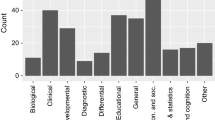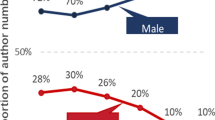Abstract
Research on the gender gap in scholarly output within the economics profession has focused almost exclusively on work done at research institutions. In that context, studies consistently find fewer publications from women than men. We examine gender patterns in research production among economists working at liberal arts colleges (LACs). To do so, we collect longitudinal reports of ECONLIT-indexed publications for scholars who earned PhDs from 1983 to 2012. While we find fewer publications per female scholar among those earning PhDs from 1983 to 2005, more recent cohorts show no gender gap. The gap seen among LAC economists earning degrees between 1983 and 1994 largely reflects differences among macroeconomists. Furthermore, while coauthorship has increased persistently across male PhD cohorts, it has leveled off among women in the most recent cohort.








Similar content being viewed by others
Notes
The only exception is Bodenhorn (1997), although gender is not the main focus of that work.
Of note, the lead article in the inaugural issue of The American Economic Review was authored by Katharine Coman, who taught economics and history at Wellesley College. https://www.aeaweb.org/articles?id=10.1257/aer.101.1.36.
The data are available through ICPSR (Bourne et al. n.d.).
We use the 10-year H index as reported by IDEAS on April 9, 2021. As explained by that source, H represents “the number of articles or papers [in the journal] with at least [H] citations.”
While we emailed all members of the population asking them to indicate their gender, the response rate was only one-in-six, too low to use for the study. However, of the 109 faculty members who reported their gender, our coding process matched in 108 cases.
Figures sum to greater than 100 percent due to rounding.
We note that our study analyzes the entire population—not a sample. As such, here and below we do not report confidence intervals or standard errors because the work involves no estimation or inference.
These percentages were calculated from Table 1 of Dolado et al.
One example of positive institutional change at LACs is the establishment in 2005 of the annual Workshop in Macroeconomic Research at Liberal Arts Colleges.
References
American Economic Association. 1991. Report of the committee on the status of women in the economics profession. The American Economic Review 81(2): 409–412.
American Economic Association. 2022. Report of the committee on the status of women in the economics profession. https://www.aeaweb.org/about-aea/committees/cswep/about/survey/annual-reports.
Auriol, Emmanuelle, Guido Friebel, Alisa Weinberger, and Sascha Wilhelm. 2022. Underrepresentation of women in the economics profession more pronounced in the United States compared to heterogeneous Europe. PNAS 119(16): e2118853119. https://doi.org/10.1073/pnas.2118853119.
Bodenhorn, Howard. 1997. Teachers, and scholars too: Economic scholarship at elite liberal arts colleges. The Journal of Economic Education 28(4): 323–336. https://doi.org/10.1080/00220489709597937.
Bodenhorn, Howard. 2003. Economic scholarship at elite liberal arts colleges: A citation analysis with rankings. The Journal of Economic Education 34(4): 341–359. https://doi.org/10.1080/00220480309595228.
Boschini, Anne, and Anna Sjögren. 2007. Is team formation gender neutral? Evidence from coauthorship patterns. Journal of Labor Economics 25(2): 325–365. https://doi.org/10.1086/510764.
Bourne, Jenny, Nathan D. Grawe, Michael Hemesath, and Maya Jensen. 2023. Scholarly Activity among Economists at Liberal Arts Colleges: A Life Cycle Analysis. The Journal of Economic Education (Forthcoming).
Bourne, Jenny, Nathan D. Grawe, Michael Hemesath, and Maya Jensen. n.d. Scholarship among liberal arts college economists. Ann Arbor, MI: Inter-University Consortium for Political and Social Research [distributor], 2022-05-06. https://doi.org/10.3886/E157982V3
Card, David, Stefano DellaVigna, Patricia Funk, and Nagore Iriberri. 2020. Are referees and editors in economics gender neutral? The Quarterly Journal of Economics 135(1): 269–327. https://doi.org/10.1093/qje/qjz035.
Ceci, Stephen J., Donna K. Ginther, Shulamit Kahn, and Wendy M. Williams. 2014. Women in academic science: A changing landscape. Psychological Science in the Public Interest 15(3): 75–141. https://doi.org/10.1177/1529100614541236.
Dimand, Robert W. 1995. The neglect of women’s contributions to economics. In Women of value: Feminist essays on the history of women in economics, eds. Mary Ann Dimand, Robert W. Dimand and Evelyn L. Forget, Edward Elgar: 1–24.
Dolado, Juan J., Florentino Felgueroso, and Miguel Almunia. 2012. Are men and women-economists evenly distributed across research fields? Some new empirical evidence. Series 3: 367–393. https://doi.org/10.1007/s13209-011-0065-4.
Ductor, Lorenzo, Sanjeev Goyal, and Anja Prummer. Forthcoming. Gender and collaboration. Review of Economics and Statistics. https://doi.org/10.1162/rest_a_01113
Forget, Evelyn L. 1995. American Women Economists, 1900–1940: Doctoral dissertations and research specialization. In Women of value: Feminist essays on the history of women in economics, eds. Mary Ann Dimand, Robert W. Dimand and Evelyn L. Forget, Edward Elgar: 25–38.
Forget, Evelyn L. 2011. American Women and the Economics profession in the Twentieth century. Oeconomia 1(1): 19–30. https://doi.org/10.4000/oeconomia.1807.
Ghosh, Pallab, and Zexuan Liu. 2020. Coauthorship and the gender gap in top economics journal publications. Applied Economics Letters 27(7): 580–590. https://doi.org/10.1080/13504851.2019.1644420.
Ginther, Donna K., and Shulamit Kahn. 2004. Women in economics: Moving up or falling off the academic career ladder? Journal of Economic Perspectives 18(3): 193–214. https://doi.org/10.1257/0895330042162386.
Ginther, Donna K., and Shulamit Kahn. 2021. Women in academic economics: Have we made progress? AEA Papers and Proceedings 111: 138–142. https://doi.org/10.1257/pandp.20211027.
Gneezy, Uri, Muriel Niederle, and Aldo Rustichini. 2003. Performance in competitive environments: Gender differences. Quarterly Journal of Economics 118(3): 1049–1074. https://doi.org/10.1162/00335530360698496.
Grossbard, Shoshana, Tansel Yilmazer, and Lingrui Zhang. 2021. The gender gap in citations of articles published in two demographic economics journals. Review of Economics of the Household 19: 677–697. https://doi.org/10.1007/s11150-020-09508-9.
Hamermesh, Daniel S. 2013. Six decades of top economics publishing: Who and how? Journal of Economic Literature 51(1): 162–172. https://doi.org/10.1257/jel.51.1.162.
Hartley, James E., and Michael D. Robinson. 1997. Economic research at national liberal arts colleges: School rankings. The Journal of Economic Education 28(4): 337–349. https://doi.org/10.1080/00220489709597938.
Hengel, Erin. 2019. Gender differences in citations at top economics journals: Even more evidence that women are held to higher standards in peer review. AEA Conference Paper, https://www.aeaweb.org/conference/2019/preliminary/paper/Y4Fdr86H.
Hengel, Erin. 2021. Publishing while Female: Are Women Held to Higher Standards? Evidence from Peer Review. The Economic Journal 132(648): 2951–2991. https://doi.org/10.1093/ej/ueac032
Hengel, Erin, and Eunyoung Moon. 2022. Gender and quality at top economics journals. Working Paper, https://erinhengel.github.io/Gender-Quality/quality.pdf.
Hilmer, Christiana, and Michael Hilmer. 2007. Women helping women, men helping women? Same-gender mentoring, initial job placements, and early career publishing success for economics PhDs. American Economic Review 97(2): 422–426. https://doi.org/10.1257/aer.97.2.422.
Hospido, Laura, and Carlos Sanz. 2021. Gender gaps in the evaluation of research: Evidence from submissions to economics conferences. Oxford Bulletin of Economics and Statistics 83(3): 590–618. https://doi.org/10.1111/obes.12409.
Huang, Junming, Alexander J. Gates, Roberta Sinatra, and Albert-László. Barabási. 2020. Historical comparison of gender inequality in scientific careers across countries and disciplines. Proceedings of the National Academy of Sciences 117(9): 4609–4616. https://doi.org/10.1073/pnas.1914221117.
Hussey, Andrew, Sheena Murray, and Wendy Stock. 2022. Gender, coauthorship, and academic outcomes in economics. Economic Inquiry 6(2): 465–484. https://doi.org/10.1111/ecin.13047.
Kolpin, Van W., and Larry D. Singell, Jr. 1996. The Gender Composition and Scholarly Performance of Economics Departments: A Test for Employment Discrimination. ILR Review 49(3): 408–423. https://doi.org/10.1177/001979399604900302
Lundberg, Shelley, and Jenna Stearns. 2019. Women in economics: Stalled progress. Journal of Economic Perspectives 33(1): 3–22. https://doi.org/10.1257/jep.33.1.3.
Manchester, Colleen, and Debra Barbezat. 2013. The effect of time use in explaining male-female productivity differences among economists. Industrial Relations 52(1): 53–77. https://doi.org/10.1111/irel.12011.
McCaughey, Robert A. 1994. Scholars and teachers: The faculties of select liberal arts colleges and their place in American Higher Learning. New York: Barnard College.
McDowell, John M., Larry D. Singell Jr, and Mark Stater. 2006. Two to Tango? Gender differences in the decisions to publish and coauthor. Economic Inquiry 44(1): 153–168. https://doi.org/10.1093/ei/cbi065.
Meade, Ellen E., Martha Starr, and Cynthia Bansak. 2021. Changes in Women’s representation in economics: New data from the AEA papers and proceedings. FEDS Notes, August 6. https://www.federalreserve.gov/econres/notes/feds-notes/changes-in-womens-representation-in-economics-new-data-from-the-aea-papers-and-proceedings-20210806.html
Niederle, Muriel, and Lise Vesterlund. 2007. Do Women shy away from competition? Do men compete too much? Quarterly Journal of Economics 122(3): 1067–1101. https://doi.org/10.1162/qjec.122.3.1067.
Sarsons, Heather. 2017. Recognition for group work: Gender differences in academia. American Economic Review 107(5): 141–145. https://doi.org/10.1257/aer.p20171126.
Sarsons, Heather, Klarita Gërxhani, Ernesto Reuben, and Arthur Schram. 2021. Gender differences in recognition for group work. Journal of Political Economy 129(1): 101–147. https://doi.org/10.1086/711401.
Siegfried, John, and Malcolm Getz. 2006. Where do the children of professors attend college? Economics of Education Review 25(2): 201–210. https://doi.org/10.1016/j.econedurev.2005.02.002.
Siegfried, John J., and Wendy A. Stock. 2007. The Undergraduate origins of PhD economists. The Journal of Economic Education 38(4): 461–482. https://doi.org/10.3200/JECE.38.4.461-482.
Squazzoni, Flaminio, Giangiacomo Bravo, Mike Farjam, Ana Marusic, Bahar Mehmani, Michael Willis, Aliaksandr Birukou, Pierpaolo Dondio, and Francisco Grimaldo. 2021. Peer review and gender bias: A study on 145 scholarly journals. Science Advances 7(2): eabd0299. https://doi.org/10.1126/sciadv.abd0299
Stock, Wendy A., T. Aldrich Finegan, and John J. Siegfried. 2009. Can you earn a Ph.D. in economics in five years? Economics of Education Review 28(5): 523–537. https://doi.org/10.1016/j.econedurev.2009.04.001
Stock, Wendy A., and John J. Siegfried. 2015. The undergraduate origins of PhD economists revisited. The Journal of Economic Education 46(2): 150–165. https://doi.org/10.1080/00220485.2015.1015187.
U.S. News Best Colleges. 2020. U.S. News and World Report. https://www.usnews.com/best-colleges
Wu, Stephen. 2005. Where do faculty receive their PhDs? A comparison across six disciplines. Academe 91(4): 53–54. https://doi.org/10.2307/40253432
Acknowledgements
Thanks to Jackson Wahl for exceptional research assistance and to Robert Lemke, Deborah DeGraff, Andrew Jalil, participants in the Carleton College Economics Seminar, and anonymous referees for thoughtful feedback that improved the paper. Work in this project was reviewed and approved by Carleton College’s Institutional Review Board (IRB 19-20 063).
Author information
Authors and Affiliations
Corresponding author
Additional information
Publisher's Note
Springer Nature remains neutral with regard to jurisdictional claims in published maps and institutional affiliations.
Rights and permissions
Springer Nature or its licensor (e.g. a society or other partner) holds exclusive rights to this article under a publishing agreement with the author(s) or other rightsholder(s); author self-archiving of the accepted manuscript version of this article is solely governed by the terms of such publishing agreement and applicable law.
About this article
Cite this article
Bourne, J., Grawe, N.D., Hemesath, M. et al. The Disappearing Gender Gap in Scholarly Publication of Economists at Liberal Arts Colleges. Eastern Econ J 50, 117–134 (2024). https://doi.org/10.1057/s41302-023-00261-2
Published:
Issue Date:
DOI: https://doi.org/10.1057/s41302-023-00261-2




